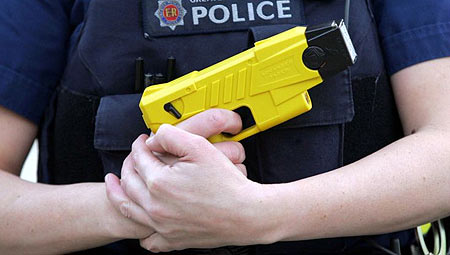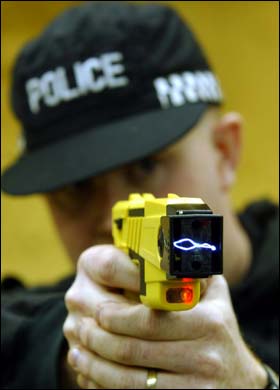 Andrew Meyer, a student at the University of Florida, after being persistent in demanding a reply during a public Q & A session on 17 September 2007 with US Senator John Kerry was eventually forced away from the area by police and then tasered repeatedly while he screamed: “Don’t tase me, bro!”
Andrew Meyer, a student at the University of Florida, after being persistent in demanding a reply during a public Q & A session on 17 September 2007 with US Senator John Kerry was eventually forced away from the area by police and then tasered repeatedly while he screamed: “Don’t tase me, bro!”
‘The reality of the fact is people are dying…There are some officers with a feel-good mentality [about] using the Taser.‘
Charles Steele Jr, African American businessman, politician and civil rights activist from Alabama
What is a Taser?
Taser is a brand name for electronic control devices (ECD) produced by Taser International Inc. The name derives from the original invention which was called Thomas A Swift’s Electric Rifle. There are several different Taser models and the current model used in the UK (apart from the unauthorised shotgun model used on Raoul Moat) is the X 26. They are described as containing electro-muscular disruption technology. The weapon delivers a 50,000v charge to the recipient which interrupts the body’s electrical system and is expected to stop an attack for several minutes.
- Pics from Flickr, under Creative Comms (Trojan631)
They cause excruciating pain.
Initially promoted as a ‘non-lethal’ weapon they have, since 1999, been accepted by their makers as a ‘less lethal’ weapon. The weapon shoots two electrodes into the body or the clothing of the victim causing uncontrollable muscle spasms. In January 2006 the United States National Academy of Forensic Engineers published a peer-reviewed study concluding that the shocks administered by the Taser are enough to cause fatal heart rhythms. This study is one of very few studies that Taser Inc. has not promoted, funded or participated in. The report makes the point that their findings show that the energy delivered by the weapon is considerably understated by the manufacturer. The US Army concluded in 2005 that Tasers could cause ventricular fibrillation the irregular heart rhythm characteristic of a heart attack.
The latest model of the Taser, the X26C, delivers an even more powerful charge. The inquiries set up in Canada and Australia into the deaths caused by the use of tasers have shown that the electrical power of these weapons can vary quite significantly contrary to the assertions of police and Taser Inc that the weapon is harmless. Weapons are not assessed regularly for their power before issue to police officers in the UK or the other countries where these weapons are used.
What assessment was made of the effects of using Tasers?
The short answer is none. Their use commenced in the US where Taser Inc. is located. No scientific tests were carried out to determine how these weapons might affect those they are used on.
In the UK it was the fact that they had been used ‘successfully’ in the US that justified their introduction here. No scientific tests were carried out despite the emergence of evidence that fatal heart arrhythmias could be caused by use. Taser has consistently provided funds, expertise and legal assistance to police officers and forces who are under investigation or litigation for taser use to encourage the continued use of their products. They have also consistently threatened medical examiners who determine the cause of death with litigation should they conclude that the death or the victim was caused by being tasered.
Initially they marketed the weapon as non-lethal and only after 10 years did they grudgingly, in the face of court judgments and civil litigation arising out of their use, concede that the weapon was not harmless and changed their description to ‘less lethal’. Later evidence caused them to issue guidance which suggested that firing at the chest of the victim should be avoided. They did not explain how the officer could persuade the victim to present his back as a target. That said many of the incidents in which tasers have been used have occurred when the victim was fleeing from the police and therefore by definition not engaged in violent confrontation.
Do Tasers kill?
Taser Inc has for years maintained that its weapons have never caused death or serious injury and that deaths and serious injuries have been caused by other factors. Amnesty International published a report in March 2006 which has been regularly updated that revealed that since June 2001 152 people had died in the USA after being shot with Tasers.
The figure now stands at over 500. Many were subjected to multiple or prolonged shocks. The United Nations Committee Against Torture (UNCAT), the agency charged with overseeing the application of the Convention against Torture and other cruel, inhuman or degrading treatments or punishments, arrived at the conclusion on 23 November 2007 that the use of ‘Taser weapons’ constituted ‘a form of torture’ and ‘can even provoke death’.
Have Tasers been effectively assessed for technical and medical issues?
Certainly not before they were introduced. Taser Inc is extremely adept at fighting any suggestion that their weapons might cause death or serious injury. They are prepared to provide money and resources to any individual police officer or police force faced with such allegations. A study carried out by the Home Office in 2001 did not focus on the damage that the weapon might do but concentrated on whether there was a potential for Tasers to ignite CS gas or other inflammable materials and the trial they carried out demonstrated that they could. A study commissioned by the Canadian Broadcasting Corporation found that of 41 Tasers tested 10% delivered significantly more current than the manufacturer said was possible underscoring the need for independent verification and testing of the devices. In 2008 an independently funded animal study in the US found that the use of Tasers can cause fatal arrhythmias in pigs. The test killed them but Taser Inc hailed that test as demonstrating that the weapons were safe.
Despite their introduction for use by police in the UK in 2005 the Home Office did not commission any examination of the health implications of the use of Tasers. ACPO has stated publicly that the use of Tasers is carefully scrutinised by the scientific and medical community and by IPCC in cases where there were fatalities. If any such research was undertaken it has not been published. Current statistics only deal with Taser use to 2009 as ‘data capture problems’ have prevented the Government from publishing them.
Existing studies which comprise tasering individuals (military and police personnel mainly), many funded by the industry manufacturing these weapons, have found that the risk of weapons causing death or serious injury is generally low in healthy adults in calm, relaxed, controlled and unstressed conditions who are protected from injuries caused when falling. These studies are, however, limited in scope and have clearly signposted the need for more understanding of the effects on vulnerable people including those exhibiting severe stress or hyperactivity, under the influence of drugs or alcohol or suffering from poor health including heart conditions. Amnesty International says ‘we are very concerned that electroshock weapons such as Tasers have been rolled out for general use before rigourous, independent testing of their effects’.
 Problems with the use of Tasers
Problems with the use of Tasers
Tasers are weapons. As such they should be governed by the same conditions that control the use of firearms by police. The problem with Tasers is that they are inherently open to abuse and suffer from ‘mission creep’ because they are easy to carry, easy-to-use and can inflict severe pain at the press of a button without leaving any substantial marks on the victim’s body. Experience in the USA and in other countries including the UK show that officers armed with Tasers use them as a method of enforcing compliance with their demands. In a sense therefore they are being used to punish people who do not do what police officers tell them to do when they are told to do it. As a consequence there are horrendous examples of the misuse of Tasers. In the USA young children have been tasered for refusing to obey police officers and in one case for refusing to go to school. The latest reported incident was a 10 year old boy tasered in school in front of his class for refusing to clean a police officer’s car. Women have been tasered because they did not produce driving licences immediately they were told to do so despite being seated in the car. Tasers have been used on elderly people, on people with obvious disabilities both mental and physical and on people who very clearly present no threat of physical violence to the police officer but merely a refusal to comply with the police officers demand. Such cases have been widely reported.
UK cases include 10 deaths which have occurred in the aftermath of the victim being tasered, the latest one being a man in Plymouth who was tasered after police had been called because he was about to commit suicide by setting himself alight. The use of the taser ignited the petrol he had poured over himself.
Another instance of inappropriate use was the tasering of an elderly blind man with a white stick who, hearing noises behind him and fearing being mugged, moved quickly away from a police officer who promptly tasered him in the back without warning and allegedly because he believed that the victim was carrying a sword. A damages claim has been filed in relation to that incident.
Experience also shows that Tasers have been used on individuals suffering from medical conditions such as seizures, on mental patients in hospital, on people having fits and undergoing mental crises, on pregnant women, on elderly people with dementia and even those who are handcuffed in police stations. Amnesty International assert that over 90 per cent of those tasered were not armed. Many are tasered for offering verbal abuse to police officers or simply not complying with a police officer’s instruction/demand.
The advent of Tasers has resulted in police officers being less inclined to use alternative or non-violent methods to resolve incidents involving such people, many of whom are behaving bizarrely and refuse the officer’s demands and orders. Non-compliance is a regular feature of drug or alcohol related incidents on our streets and has been long before tasers were introduced. This suggests that arming police officers with Tasers would be to move from policing by consent to violent resolution of incidents as the norm as well as the use of the weapon to produce compliance through pain or retribution. It also shows that possession of a Taser seems to rule out non-violent methods which were the norm for resolving incidents. Research shows that on the streets the victim will usually be mentally and/or physically unsound (often because of alcohol and/or drugs), in a state of high stress and in the midst of a confrontation with police. In over 90% of the cases where death or serious injury occurs as a result of the use of a Taser the victims pose no serious threat to the life of an officer or the public. Mental health charities, charities representing the elderly and infirm and charities for the disabled have been vocal in condemning the use of tasers on victims who fall into these categories.
UK police do not have as standard the model issued by Taser which has a video camera incorporated and records what is going on when the Taser is used. This means that absent a quick thinking member of the public with a phone camera many incidents come down to conflicting recollections and conflicting testimony between the police and the victim (assuming they survive).
The UK Defence Scientific Advisory Council’s Subcommittee on the Medical Implications of Less Lethal Weapons stated in 2007 ‘the possibility that other factors such as illicit drug intoxication, alcohol abuse, pre-existing heart disease, and cardio active therapeutic drugs may modify the threshold for the generation of cardiac arrhythmias cannot be excluded’. They went on to say ‘experiments by Taser do not take into account real-life use of Tasers by law enforcement agencies such as repeated or prolonged shocks and the use of restraints’.
Initially Tasers were issued to Authorised Firearm Officers (AFO) trained and to use firearms and their use was limited to incidents where they were facing violence of such severity that force was needed to protect the police or the public. Currently there are 14,700 officer trained to use Tasers.
The number of AFO’s is 6,979. Additionally MOD Police have been issued Tasers but no statistics are available for their use. However daily the number of officers authorised to use Tasers is increasing as Police Forces move to a default position that Tasers are standard issue to all officers. This is supported by demands from ACPO, PCC’s and from the Police Federation for all police officers to be armed with Tasers routinely. This demand received increased vocalisation in the aftermath of the shooting of two officers in Manchester this year in an incident where one officer had a Taser but Tasers would not have altered the outcome.
And what of the future? More, different and lethal weapons are in development including a new generation of ECD’s. Other devices include microwave beams, acoustic blasts and knockout drugs which will join Tasers in the police officer’s armoury.







